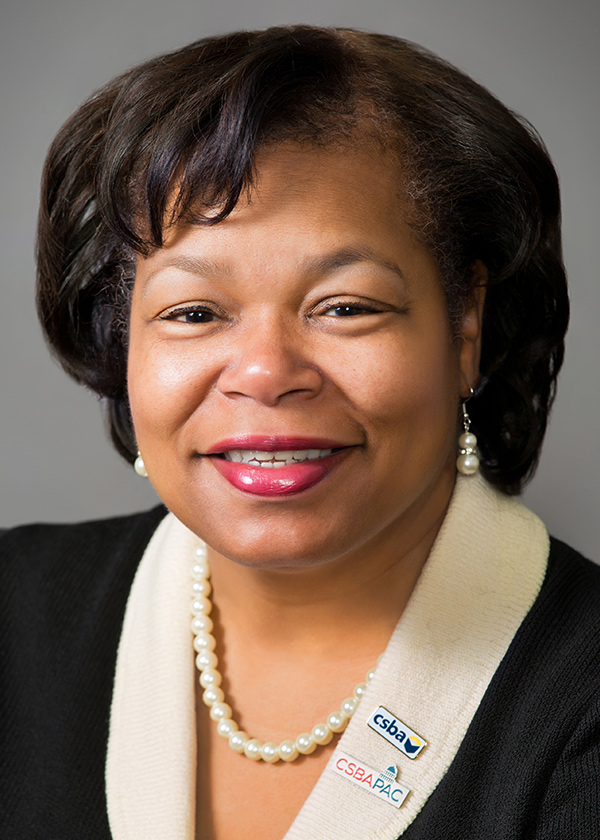

Forty-four members of the Assembly voted “aye” on the bill, with 20 members voting no and 15 declining to vote. In 2018, a prior version of SB 328 squeaked through the Assembly and was ultimately vetoed by then-Gov. Jerry Brown. CSBA continues to oppose the statewide mandate contained in SB 328, as decisions related to school start times should be made by locally elected boards with input from local communities.
Both the Senate and Assembly adjourned at approximately 3 a.m. on Sept. 14, having concluded their 2019 business, moving a number of bills between the houses to be heard in the final hours. All told, nearly 70 bills on which CSBA had adopted a formal legislative position have been sent to Gov. Newsom, 16 of which have already been signed into law as of this writing.
- Visit www.csba.org/Newsroom for links to digital versions of current and past issues of California School News.
- Visit blog.csba.org for the latest in CSBA education news.

As part of this work, CSBA established an Equity Network in 2018 for school board members, funded through a grant from the Stuart Foundation. This network is a platform for participants to collaborate, build capacity and inform decisions that lead to improved opportunities and outcomes for underserved students. In April 2019, the first cohort of 20 board members, representing 10 districts, concluded its year-long series of in-person and virtual meetings — read more about the work of this group in the fall issue of California Schools magazine. This August, a new cohort of participants convened to continue these important conversations. Meanwhile, participants from the first year continue with support activities to implement their equity action plans.

Senior Director of Communications:
Troy Flint | tflint@csba.org
Managing Editor:
Kimberly Sellery | ksellery@csba.org
Marketing Director:
Serina Pruitt | spruitt@csba.org
Staff Writers and Contributors:
Andrew Cummins | acummins@csba.org
Aaron Davis | adavis@csba.org
Alisha Kirby | akirby@csba.org
Briana Mullen | bmullen@csba.org
Bode Owoyele | bowoyele@csba.org
Graphic Design Manager:
Kerry Macklin | kmacklin@csba.org
Senior Graphic Designer:
Mauricio Miranda | mmiranda@csba.org
Emma Turner | La Mesa-Spring Valley SD
President-elect:
Xilonin Cruz-Gonzalez | Azusa USD
Vice President:
Tamara Otero | Cajon Valley Union USD
Immediate Past President:
Mike Walsh | Butte COE
CEO & Executive Director:
Vernon M. Billy
News and feature items submitted for publication are edited for style and space as necessary.


Call for nominations for CSBA’s Delegate Assembly will open Friday, Nov. 1, 2019. CSBA member boards may nominate board members to run for election until Tuesday, Jan. 7, 2020. Nominees are required to submit a completed, signed and dated biographical sketch form by Jan. 7; an optional one-page, one-sided resume may be submitted as well. The election period for boards to vote runs from Saturday, Feb. 1 to Monday, March 16, 2020. Elected Delegates serve two-year terms beginning April 1, 2020 through March 31, 2022.
CSBA’s Delegate Assembly is a vital link in the association’s governance structure. Working with local districts, county offices of education, the board of directors and officers, Delegates ensure that the association reflects the interests of school districts and county offices of education. In addition, they elect CSBA’s officers and board of directors, adopt the Policy Platform and Bylaws, serve on committees and provide advocacy on behalf of public education and boards of education.
Visit www.csba.org/ElectiontoDA for more information about CSBA’s Delegate Assembly, including the nomination and election process, and to obtain relevant documents.

Setting goals is a key function of a successful governing board. The start of the school year is the ideal time for boards to develop goals that will set the board’s direction for the year and reflect a focus on student learning and achievement.
To help guide the discussion, boards can consider the following questions when setting school district or county office of education board goals:
- How do our goals directly support student achievement?
- How are resources allocated to support these goals?
- How will we communicate our agreed-upon goals to staff and stakeholders?
- Are our goals meant to help every student in the district succeed? Are the goals equity-based?
- Have we built goal-setting meetings into our governance calendar?
- What are the success indicators for the goals set and are they quantifiable?
- Did every board member have an equal voice in setting the goals? What does our goal-setting meeting look like?
- Once the district/COE goals are set, are they strategically reviewed, and success indicators examined?
Equally important, boards should set agenda time at the end of the year to review the goals and discuss their progress. The true measurement of goals is reflected in increased student achievement and value-added programs. Goals are a top priority that need consistent attention and committed resources to be reached.
CSBA’s Masters in Governance courses can help board members to understand the importance of setting goals for their district or county office. Course 1 focuses on Effective Governance and Setting Direction; more information on MIG is available at www.csba.org under the Trainings and Events tab.
CSBA’s Nominating Committee met on Sept. 14, 2019, to interview the following candidates for President-elect and Vice President of CSBA. For President-elect: Tamara Otero, Cajon Valley Union SD, and Suzanne Kitchens, Pleasant Valley SD. For Vice President: Susan Heredia, Natomas USD.
Following the interviews and the committee’s deliberations, the committee nominated Tamara Otero, and Suzanne Kitchens as candidates for President-elect. As candidate for Vice President, the committee nominated Susan Heredia.
As provided in CSBA’s Standing Rules, qualified individuals interested in being nominated from the floor of the Delegate Assembly must submit a complete Declaration of Candidacy packet, along with their written intention to run, on or before Friday, Nov. 1, 2019. Intentions to run from the floor for President-elect and Vice President must be submitted to CSBA President Emma Turner at eturner@csba.org and the Chair of the Nominating Committee, Susan Scott at sue.scott@leusd.k12.ca.us.
Statutory changes largely call for several user- and parent-friendly changes to be incorporated into the revised LCAP template that was presented at the meeting. To better track spending, the law now requires that the template consolidate expenditures in summary tables to make it easier for stakeholders to see the full picture. According to the California Department of Education staff analysis, implementing this change could substantially reduce the length of most LCAPs, a transparency issued raised by many organizations and individuals in recent years.
Further, a summary table will clearly specify whether actions to increase or improve educational services are being provided throughout the entire local educational agency, targeted to specific high-need student groups or provided at individual school sites. The change is meant to “allow LEAs and stakeholders to quickly understand how increased or improved services are being provided and have the necessary conversations about whether the proposed approach is aligned with local priorities.”
When the most recent amendment to Elections Code Section 15372 took effect on Jan. 1, 2015, the deadline for elections officials to certify election results was moved from 28 days after the election to 30 days after the election. This was to allow elections officials more time to canvass votes cast in an election. In a development steeped in irony, that extension of time itself created an anomalous situation with respect to some governing and county board elections that needed to be resolved.
the Caribbean and Central and South America.
More than half of California’s students are Hispanic and/or Latino and schools play a critical role in preparing these students for success in college, career and civic life. California School News interviewed Joaquin Rivera, CSBA’s Director-at-Large, Hispanic and trustee on the Alameda County Board of Education, for his perspectives on this growing student population.
Tell us a little about your background — what made you want to be a school board member? What motivated you to become involved with CSBA?
Growing up in Puerto Rico, my parents were public school administrators and they instilled in me the importance of education. In addition, I had many good and inspiring teachers along the way who served as role models. I have a bachelor’s of science in chemistry from the University of Puerto Rico, Mayaguez and a master’s of science in chemistry from UC Berkeley. I’m a community college chemistry professor. I served on the Berkeley School Board for 12 years and have been a member of the Alameda County Board of Education for the last nine. Education has always been very important in my life and I wanted to make a difference in the lives of the students in my community and the state of California. Serving my community has always been a life goal. That’s why I ran for school board and became involved with CSBA.

California School Boards Association CEO & Executive Director Vernon M. Billy moderated a panel that examined how collaboration across local and state policy and advocacy groups would be necessary to ensure children throughout California are supported and given all opportunities to succeed.
To provide such resources, however, panelists agreed that districts need more money than has been provided in the last decade, even with the increases in state funding in the last couple of years.
“Money may not be everything,” Billy said, “but it is necessary if you want to provide the best for our students and teachers. Districts throughout the state are struggling to do what these outlier districts are doing.”
California currently ranks 38th in per-pupil funding and 45th in student–teacher ratios, despite being the fifth-largest economy in the world.
Wes Smith, executive director of the Association of California School Administrators, called on event attendees to tell their lawmakers to invest in Full and Fair Funding. Systems of support for students and teachers break down as early as pre-K, he said, and school districts need the funding to implement programs and provide resources to ensure all children are able to thrive in California’s public schools.
Sofia Friere, chief of leadership and learning at San Diego USD, said that much of her district’s success was attributable to spending and policy decisions guided by the superintendent and school board’s commitment to equity. The district, Friere said, aims to achieve equity in all its schools by “giving every student what they need, how they need it and when they need it.”
The increased advocacy efforts were on full display with this session’s charter school legislation, a topic addressed throughout the gathering, particularly with the compromise on Assembly Bill 1505 (O’Donnell, D-Long Beach). Earlier versions of AB 1505 would have significantly limited the authority of county boards over charter schools, Dean said.
One guiding principle of the Santa Cruz County Career Advancement Charter School is to help remove individual and systemic barriers that have historically prevented students from succeeding in our educational system. The CAC has multiple locations across Santa Cruz County that offer a range of services including independent study, in-class instruction for high school completion, Career and Technical Education classes, English as a second language, therapeutic support and academic guidance. Services are offered throughout the day to accommodate student schedules, which often revolve around each student’s professional and family responsibilities.
Districts that would like to set up international exchange programs should become knowledgeable of the requirements and develop policy and procedures to ensure the eligibility, safety and well-being of visiting students.
Masters in Governance Courses 3 & 4
Masters in Governance Courses 3 & 4
2019 The Brown Act
Masters in Governance Course 5
2019 The Brown Act
Masters in Governance Course 5
CSBA Annual Education Conference and Trade Show





